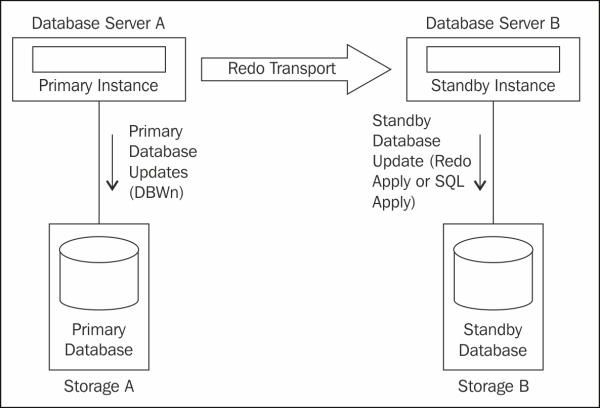The objective of this chapter is to make you familiar with the Oracle Data Guard 11gR2 environment. We will discuss the definition, properties, and history of Data Guard. You will become accustomed with the concepts of standby databases and how Data Guard provides the robust solution of high availability and disaster recovery.
In this chapter, we will discuss the following topics:
- The definition and features of Data Guard
- The evolution of Data Guard
- The architecture and topology of Data Guard
- Comparison of Data Guard with other replication solutions
Let's get on with learning what Oracle Data Guard is and its primary features are.
Data Guard, which was introduced as the standby database in Oracle database Version 7.3 under the name of Data Guard with Version 9i, is a data protection and availability solution for Oracle databases. The basic function of Oracle Data Guard is to keep a synchronized copy of a database as standby, in order to make provision, incase the primary database is inaccessible to end users. These cases are hardware errors, natural disasters, and so on. Each new Oracle release added new functionalities to Data Guard and the product became more and more popular with offerings such as data protection, high availability, and disaster recovery for Oracle databases.
Using Oracle Data Guard, it's possible to direct user connections to a Data Guard standby database automatically with no data loss, in case of an outage in the primary database. Data Guard also offers taking advantage of the standby database for reporting, test, and backup offloading. Corruptions on the primary database may be fixed automatically by using the non-corrupted data blocks on the standby database. There will be minimal outages (seconds to minutes) on the primary database in planned maintenances such as patching and hardware changes by using the switchover feature of Data Guard, which changes the roles of the primary and standby databases. All of these features are available with Data Guard, which doesn't require an installation but a cloning and configuration of the Oracle database.
A Data Guard configuration consists of two main components: primary database and standby database. The primary database is the database for which we want to take precaution for its inaccessibility. Fundamentally, changes on the data of the primary database are passed through the standby database and these changes are applied to the standby database in order to keep it synchronized.
The following figure shows the general structure of Data Guard:

Let's look at the standby database and its properties more closely.
